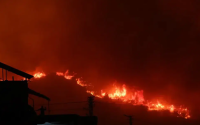23 June 2007Yahoo! News
The development of Canada's oil sands is laying waste to its great northern forest and western plains, say critics who point to skyrocketing greenhouse gas emissions, diverted rivers and razed backwoods.
And the devastation can only get worse, they say, as energy companies pump billions of dollars into new projects to triple local oil production to some 3.0 million barrels per day within the next decade.
The Athabasca, Peace River and Cold Lake Oil Sands, at an estimated 173 billion barrels, rank second behind Saudi Arabia in petroleum resources.
But due to high extraction costs, the deposits were long neglected except by local companies.
While conventional crude oil is pumped from the ground, oil sands must be mined and bitumen separated from the sand and water, then upgraded and refined
.
Since 2000, skyrocketing crude oil prices (now at about 70 dollars a barrel) and improved extraction methods have made it more economical to exploit the sands, and lured several international oil companies to mine the sands.
Open pits now dot the northern part of Alberta province where vast tracts of the Boreal Forest once stood, and giant mechanical shovels now devour black oil-encrusted soil day and night.
In an article in the June 2006 issue of Rolling Stone magazine, former US presidential candidate Al Gore offered a scathing sketch of the oil sands industry as wasteful and a blight on Canada.
"For every barrel of oil they extract there, they have to use enough natural gas to heat a family's home for four days," Gore told the magazine.
"And they have to tear up four tonnes of landscape, all for one barrel of oil. It is truly nuts," he said, urging Americans, who are the main buyers of Canadian oil, to break their addiction to oil.
For Canada, which has stepped back from its 1997 Kyoto Protocol commitment to reduce carbon dioxide emissions to 6.0 percent below 1990 levels by 2012, the oil sands boom is a mixed blessing.
It creates wealth and jobs, but the industry is already Canada's worst polluter and is bound to double its harmful CO2 emissions by 2015, now at 29 megatonnes annually, according to a government environmental audit.
"It's almost impossible for us to reduce our greenhouse gas emissions if we want to boost production from 2,000 to 250,000 barrels within a decade," said Michael Borrell, president of Total Canada, a scion of the French oil behemoth Total SA.
The government has proposed a 20 percent reduction in the "intensity" of the sector's CO2 emissions, but total emissions would still rise as oil production billows.
The boom is also prompting fears of local water shortages and declining water quality as oil companies drain 349 million cubic meters of water from the Athabasca River each year for use in oil production, then dump it into area tailing ponds.
A report by the Sage Centre and the World Wildlife Fund (WWF) on global warming said Alberta would have to curtail new oil sands projects, which now use 2.0 to 4.5 barrels of water and large amounts of energy to produce one barrel of oil, if warming persists.
The WWF called for no new water-taking permits for energy companies, noting water flows in the Athabasca River, down 20 percent since 1958, could diminish by another seven to 10 percent if temperatures continue to rise.
"Climate change (is) an issue because the flow in the Athabasca River has constantly been dropping and as the glaciers (that feed the river) disappear in Jasper National Park, it's gonna get worse," said Simon Dyer of the Pembina Institute, an environmental group.
"Those people they just don't care about the environment," said Terry, a young aboriginal in Fort McKay in the heart of the oil sands. "Some people fish (in the Athabasca River) for fun ... but nobody should eat the fish around here."
Higher than average cancer rates at the nearby Fort Chipewyan Indian Reserve were recently linked to oil industry contamination of the environment, said reports.
Alberta law requires oil companies to restore excavated lands, but out of some 44,000 square kilometers (17,000 square miles) leased to them since 1967, "not a single square meter (foot) of land has been reclaimed," Dyer lamented.






